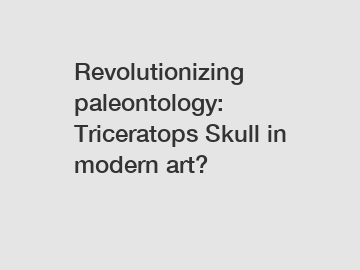Revolutionizing paleontology: Triceratops Skull in modern art?
Have you ever thought about how ancient artifacts can impact modern art? Well, one such example is the recent incorporation of a Triceratops skull into modern artwork. This innovation in paleontology has the potential to revolutionize the way we view and appreciate prehistoric artifacts. Let's delve into this fascinating intersection of science and art.
A Rare Find.
The Triceratops skull, discovered in a remote area of Montana, is a rare and significant find in the field of paleontology. It is believed to be over 65 million years old, making it a valuable piece of history. The skull is remarkably well-preserved, showcasing intricate details of the Triceratops species.

The skull's journey from excavation to exhibition has been met with much excitement and interest from both scientists and artists. Its unique features and historical significance have inspired creativity and curiosity among those who have had the privilege of witnessing it.
Bridging the Gap.
The integration of the Triceratops skull into modern art is a groundbreaking development that bridges the gap between the past and present. By incorporating such a rare and ancient artifact into contemporary artwork, artists are able to create connections between different time periods and stimulate conversations about evolution, extinction, and the natural world.
This fusion of paleontology and art has the potential to captivate audiences and ignite a sense of wonder and exploration. It challenges traditional boundaries and opens up new possibilities for creative expression and interpretation.
Embracing Innovation.
The use of the Triceratops skull in modern art signifies a new era of innovation and collaboration in the field of paleontology. It highlights the importance of creativity and imagination in scientific research and discovery. By exploring new ways to showcase and interpret ancient artifacts, scientists and artists can enhance our understanding and appreciation of the natural world.
The integration of paleontological findings into artistic works opens up a world of possibilities for interdisciplinary collaboration and exploration. It encourages us to push the boundaries of what is possible and imagine new ways of connecting with our past.
Closing Thoughts.
The Triceratops skull in modern art is a testament to the power of creativity and curiosity in driving innovation and discovery. By merging the worlds of paleontology and art, we are able to create new narratives and perspectives that challenge our understanding of the past and inspire us to imagine the future.
If you are interested in learning more about this revolutionary integration of paleontology and art, contact us. Our team of experts can provide you with information on how to incorporate ancient artifacts into your own artistic endeavors. Don't miss the opportunity to be a part of this exciting movement in the world of science and art. Remember, the supplier is just a click away.
If you want to learn more, please visit our website fiberglass t-rex dinosaur, life size dinosaur costumes, animatronic animal with sound.



